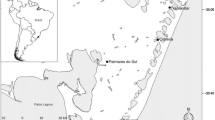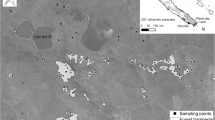Abstract
The evidence of microclimatic edge effects through forest/open area ecotones is firm. How this affects the species composition near edges is less well understood and documented. In south-western South Africa shrub-dominated regularly burnt vegetation (i.e. fynbos) is the most common vegetation with indigenous temperate forests naturally occurring mostly in ravines on mountain slopes. The size and width of these forest patches varies considerably. In order to understand how the width of forest patches affects species composition of mosses and liverworts we investigated 20 forest patches of different width. In each forest patch we compiled a total species list, and collected data on selected environmental variables, for a plot of 10×20 m. No significant relationship was found between patch width and the number of either moss or liverwort species. However, the species composition of mosses (but not liverworts) changed along the gradient of patch width. The variation in number of species was large (8–29 mosses and 11–33 liverworts) among the plots and we propose that factors other than distance to the forest edge may be more important in structuring the bryophyte community of these ravine forests. One such factor that is likely to be important is the climatic difference among the plots. There is variation in features, such as precipitation, summer temperature, cloudiness, and the amount of fog, for which we do not have data but that could overrule the microclimatic differences due to edge effects.
Similar content being viewed by others
References
Acebey A, Gradstein SR, Krömer T (2003) Species richness and habitat diversification of bryophytes in submontane rain forest and fallows of Bolivia. J Trop Ecol 19:9–18
Archibold OW (1995) Ecology of world vegetation. Chapman and Hall, London
Baldwin LK, Bradfield GE (2005) Bryophyte community differences between edge and interior environments in temperate rain-forest fragments of coastal British Columbia. Can J For Res 35:580–592
Brualdi RA, Sanderson JG (1999) Nested species subsets, gaps, and discrepancy. Oecologia 119:256–264
Cadenasso ML, Pickett STA, Weathers KC, Jones CG (2003) A framework for a theory of ecological boundaries. BioScience 53:750–758
Campbell BM, Moll EJ (1977) The forest communities of Table Mountain, South Africa. Vegetatio 34: 105–115
Chen JQ, Franklin JF, Spies TA (1995) Growing-season microclimatic gradients from clear-cut edges into old-growth Douglas-Fir forests. Ecol Appl 5:74–86
Cornelissen JHC, ter Steege H (1989) Distribution and ecology of epiphytic bryophytes and lichens in dry evergreen forest of Guyana. J Trop Ecol 5:131–150
Cowling RM, Holmes PM (1992) Flora and vegetation. In: Cowling R (ed) The ecology of fynbos: nutrients, fire and diversity. Oxford University Press, Cape Town, pp 23–61
Cowling RM, Richardson D (1995) Fynbos: South Africas unique floral kingdom. Institute for Plant Conservation, Fernwood Press, Vlaeberg, South Africa
Cowling RM, Holmes PM, Rebelo AG (1992) Plant diversity and endemism. In: Cowling R (ed) The ecology of fynbos: nutrients, fire and diversity. Oxford University Press, Cape Town, pp 62–111
Davies-Colley RJ, Payne GW, van Elswijk M (2000) Microclimate gradients across a forest edge. N Z J␣Ecol 24:111–121
Didham RK, Lawton JH (1999) Edge structure determines the magnitude of changes in microclimate and vegetation structure in tropical forest fragments. Biotropica 31:17–30
Drehwald U (2005) Biomonitoring of disturbance in neotropical rainforests using bryophytes as indicators. J␣Hattori Bot Lab 97:117–126
Eeley HAC, Lawes MJ, Reyers B (2001) Priority areas for the conservation of subtropical indigenous forest in southern Africa: a case study from KwaZulu-Natal. Biodivers Conserv 10:1221–1246
Esseen PA, Renhorn KE (1998) Edge effects on an epiphytic lichen in fragmented forests. Conserv Biol 12:1307–1317
Frahm JP (1994) Scientific results of the BRYOTROP expedition to Zaire and Rwanda. 2. The altitudinal zonation of the bryophytes on Mt. Kahuzi, Zaire. Trop Bryol 9:153–167
Frahm JP, Gradstein SR (1991) An altitudinal zonation of tropical rain forests using bryophytes. J Biogeogr 18:669–678
Frahm JP, Ohlemüller R (2001) Ecology of bryophytes along altitudinal and latitudinal gradients in New Zealand. Studies in austral temperate rain forest bryophytes 15. Trop Bryol 20:117–137
Frahm JP, Porembski S, Seine R, Barthlott W (1996) Mosses in the inselbergs of Cote d’Ivoire and Zimbabwe. Nova Hedwigia 62:177–189
Gotelli NJ (1991) Metapopulation models – the rescue effect, the propagule rain, and the core-satellite hypothesis. Am Nat 138:768–776
Gradstein SR, Montfoort D, Cornelissen JHC (1990) Species richness and phytogeography of the Bryophyte flora of the Guianas, with special reference to the lowland forest. Trop Bryol 2:117–126
Hylander K (2005) Aspect modifies the magnitude of edge effects on bryophyte growth in boreal forests. J␣Appl Ecol 42:518–525
Hylander K, Jonsson BG, Nilsson C (2002) Evaluating buffer strips along boreal streams using bryophytes as indicators. Ecol Appl 12:797–806
Hylander K, Dynesius M, Jonsson BG, Nilsson C (2005) Substrate form determines the fate of bryophytes in riparian buffer strips. Ecol Appl 15:674–688
Jonsson BG (2001) A null model for randomization tests of nestedness in species assemblages. Oecologia 127:309–313
Kelly DL, O’Donovan G, Feehan J, Murphy S, Drangeid SO, Marcano-Berti L (2004) The epiphyte communities of a montane rain forest in the Andes of Venezuela: patterns in the distribution of the flora. J Trop Ecol 20:643–666
Kotze DJ, Samways MJ (2001) No general edge effects for invertebrates at Afromontane forest/grassland ecotones. Biodivers Conserv 10:443–466
Kürschner H (1999) Life strategies of epiphytic bryophytes in Mediterranean Pinus woodlands and Platanus orientalis alluvial forests of Turkey. Cryptogam Bryol 20:17–33
Kürschner H, Frey W (1999) Patterns and adaptive trends of life forms, life strategies and ecomorphological structures in tropical epiphyte bryophytes – a pantropical synopsis. Nova Hedwigia 69:73–99
Lawrence RF (1950) The biology of the cryptic fauna of forests with special reference to the indigenous forests of South Africa. A.A. Balkema, Cape Town
Leibold MA, Mikkelson GM (2002) Coherence, species turnover, and boundary clumping: elements of meta-community structure. Oikos 97:237–250
Luczaj L, Sadowska B (1997) Edge effect in different groups of organisms: vascular plants, bryophyte and fungi species richness across a forest-grassland border. Folia Geobot Phytotaxon 32:343–353
McCune B, Mefford MJ (1999) PC-ORD. Multivariate analysis of ecological data. MjM Software Design, Gleneden Beach, Oregon, USA
McKenzie B, Moll EJ, Campbell BM (1977) A phytosociological study of Orange kloof, Table Mountain, South Africa. Vegetatio 34:41–53
Merwin MC, Nadkarni NM (2001) 100 years of tropical bryophyte and lichen ecology: a bibliographic guide to the literature from 1901 to 2000. Trop Bryol 21:97–118
Moen J, Jonsson BG (2003) Edge effects on liverworts and lichens in forest patches in a mosaic of boreal forest and wetland. Conserv Biol 17:380–388
Moll EJ, Trinder-Smith T (1992) Invasion and control of alien woody plants on the Cape Peninsula Mountains, South Africa – 30 years on. Biol Conserv 60:135–143
Murcia C (1995) Edge effects in fragmented forests – implications for conservation. Trends Ecol Evol 10:58–62
Norušis MJ (1999) SPSS for windows, version 10.0. SPSS, Chicago, IL
Pauw A, Johnson S (1999) Table Mountain: a natural history. Fernwood Press, Vlaeberg, South Africa
Pharo EJ, Beattie A (1997) Bryophyte and lichen diversity: a comparative study. Aust J Ecol 22:151–162
Pharo EJ, Lindenmayer DB, Taws N (2004) The effect of large-scale fragmentation on bryophytes in temperate forests. J Appl Ecol 41:910–921
Pharo EJ, Kirkpatrick JB, Gilfedder L, Mendel L, Turner PAM (2005) Predicting bryophyte diversity in grassland and eucalypt-dominated remnants in subhumid Tasmania. J Biogeogr 32:2015–2024
Ries L, Fletcher RJ Jr, Battin J, Sisk TD (2004) Ecological responses to habitat edges: mechanisms, models, and variability explained. Annu Rev Ecol Evol Syst 35:491–522
Rosenzweig L (1995) Species diversity in space and time. Cambridge University Press, Cambridge, UK
Roux JP (1979) Cape Peninsula ferns. National Botanical Gardens of South Africa, Cape & Transvaal Printers, Cape Town
Russell S (1982) Humidity gradients and bryophyte zonation in the afromontane forests of the eastern Cape, South Africa. J Hattori Bot Lab 52:299–302
Russell S (1992) Bryofloristic relationships within southern African forests. Bull Br Bryol Soc 59:11
Sillett SC, Gradstein SR, Griffin D (1995) Bryophyte diversity of Ficus tree crowns from cloud forest and pasture in Costa Rica. The Bryologist 98:251–260
ter Braak CJF, Prentice IC (1988) A theory of gradient analysis. Adv Ecol Res 18:271–317
van Rooy J, Perold SM (2003) Bryophyta, Hepatophyta and Anthocerotophyta. In: Germishuizen G, Meyer NL (eds) Plants of southern Africa: an annotated checklist. Strelizia 14:2–63
Versfeld DB, Richardson DM, van Wilgen BW, Chapman RA, Forsyth GG (1992) The climate of Swartboskloof. In: van Wilgen BW, Richardson DM, Kruger FJ, van Hensbergen HJ (eds) Fire in South African mountain fynbos: ecosystem, community and species response at Swartboskloof. Ecological studies, vol 93. Springer-Verlag, Berlin, pp 21–35
Wishart MJ, Hughes JM (2001) Exploring patterns of population subdivision in the net-winged midge, Elporia barnardi (Diptera: Blephariceridae), in mountain streams of the south-western Cape, South Africa. Freshwater Biol 46:479–490
White F (1978) The afromontane region. In: Werger MJA (ed) Biogeography and ecology of Southern Africa. W. Junk, The Hague, pp 463–514
Wolf JHD (1993) Diversity patterns and biomass of epiphytic bryophytes and lichens along an altitudinal gradient in the northern Andes. Ann Miss Bot Garden 80:928–960
Zartman CE (2003) Habitat fragmentation impacts on epiphyllous bryophyte communities in central Amazonia. Ecology 84:948–954
Zartman CE, Nascimento HEM (2006) Are habitat-tracking metacommunities dispersal limited? Inferences from abundance-occupancy patterns of epiphylls in Amazonian forest fragments. Biol Conserv 127:46–54
Acknowledgements
Thanks to Prof. Robert Magill, Prof. Tamás Pócs, and Prof. Ryszard Ochyra for help with identification of several specimens. We thank Tracy Nowel and Samuel Hylander for assistance in the field. Thanks to Prof. William Bond for interesting discussions and valuable input to the study. Permission to work in the protected areas was given by the Western Cape Nature Conservation Board. Climatic data were generously provided by the South African Weather Bureau. The study was financed by grants from The Swedish Foundation for International Cooperation in Research and Higher Education (STINT), The Royal Swedish Academy of Sciences (KVA), Swedish Research Council (former NFR) and Wahlenbergsmedel at Umeå University (to K.H.).
Author information
Authors and Affiliations
Corresponding author
Appendix
Appendix
Rights and permissions
About this article
Cite this article
Hylander, K., Hedderson, T.A.J. Does the width of isolated ravine forests influence moss and liverwort diversity and composition?—A study of temperate forests in South Africa. Biodivers Conserv 16, 1441–1458 (2007). https://doi.org/10.1007/s10531-006-9006-0
Received:
Accepted:
Published:
Issue Date:
DOI: https://doi.org/10.1007/s10531-006-9006-0




